Mercer Family of Stoops, Great Harwood
Family line of John Mercer, Chemist
Of all the Mercer families of Great Harwood the one that generates the most interest and queries is that of John Mercer the chemist. This isn’t surprising – at the very centre of the town is the Mercer Memorial Clock celebrating his life and achievements and on Queen Street stands the imposing Mercer Hall, erected with funds provided by Maria Mercer, daughter of John Mercer.
Sadly however, of all the various Mercer clans originating in the town, this line cannot be traced any further back than the grandfather of John Mercer, Thomas Mercer of Stoops.
For many years there was no way to know the birthdate of Thomas Mercer: if his burial has been recorded it is not clear which burial it may be and therefore his age at death isn’t known from which to estimate a date of birth. However, a survey of Nowell lands made in 1765 reveals that he was born about 1710. In the survey his age was given as 55, and the ages of the other lives in the survey are within two years of their baptisms so there is little reason to doubt this information as it was a legal document relating to land tenancy.
A look at the parish registers reveals several baptisms for children named Thomas Mercer around 1710, but most can be accounted for as follows:
- 1706 Son of Richard – probably buried in 1711.
- 1709 Son of John – Cowden line
- 1714 Son of Richard – Cowden line buried 1715.
- 1715 Son of James – Egg Syke line
- 1716 Son of Richard – Lower Fold line
Around this time several men named Mercer moved, with their families, to live in Great Harwood. It is possible they originated from Great Harwood families but had moved to West Yorkshire at some point, and any of these men could have had a son named Thomas:
- 1708 Richard Mercer Soyland, West Riding Mary his wife.
- 1712 Edward Mercer Midgeley, Ebor. & Eliz.
- 1711 John Marcer Sowerby, West Riding Son of Robert Mercer of Great Harwood
The parish registers of Great Harwood seem to be complete, but an in-depth examination soon reveals that there are many omissions; Thomas may have been born in Great Harwood, but either he wasn’t baptised or his baptism wasn’t recorded. Thomas was the tenant at Stoops farm, which was one of the larger farms in the town. It was usual for any tenement of any size and importance to be leased to someone whose skill or potential were known, and very often continued to be leased to members of the same family for many generations – it is likely that Thomas was not a stranger to the town, but until further evidence comes to light it is impossible to say from which family he originated.
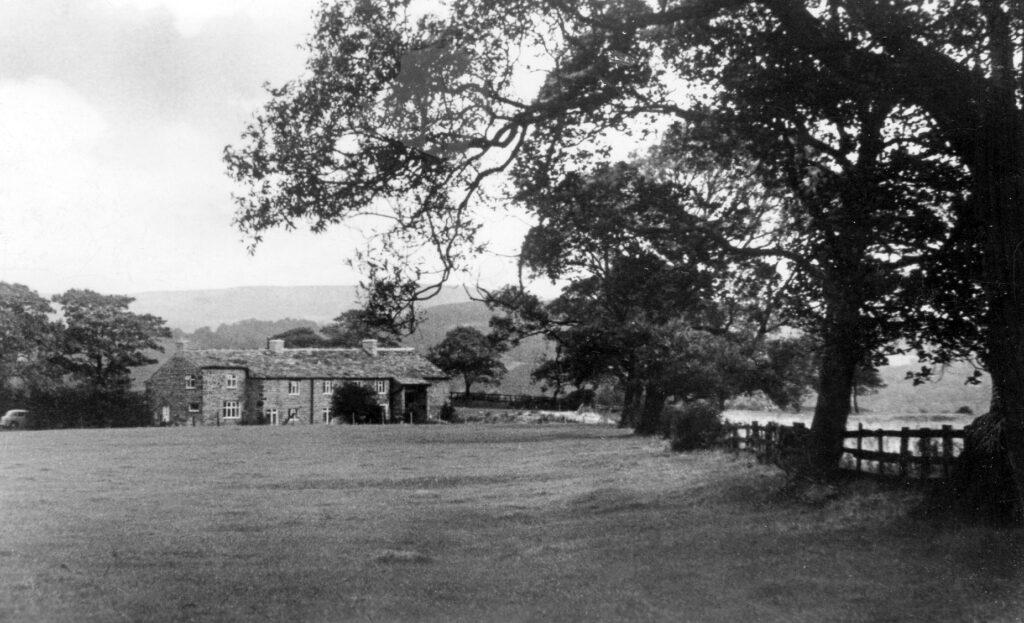
Stoops appears to have been built and its lands created from Park Tenement in the early years of the eighteenth century. The first occupiers were probably Elizabeth the daughter of Alexander Nowell of Roger Hey and her husband John Smalley, but Elizabeth died quite young and the family moved. There is another place named Stoops on Whalley Banks in Great Harwood and there was Stopes in the town centre; because of this it is difficult at times to know which place was meant when mentioned in the records. Stoops refers to guideposts erected at crossroads on major routes – which fits the location of Stoops perfectly – the road at one time curved around the east of the house.
It is also not certain when and who Thomas married, again there are several marriages in the years before the first child born at Stoops is recorded:
- Marriage: 2 Feb 1740/1 St Bartholomew, Great Harwood, Lancashire, England – Tho. Mercer – Harwood and Elizabeth Hindle – Harwood
- Marriage: 26 Sep 1741 St Mary the Virgin, Blackburn, Lancashire, England – Thomas Mercer – Great Harwood and Alice West – Little Harwood
- Marriage: 3 Jan 1743/4 St Bartholomew, Great Harwood, Lancashire, England – Tho. Mercer – Husbandman, Harwood and Ann Kitchen – Wiswel in ye parish of Whalley
- Marriage: 13 Apr 1746 St Bartholomew, Great Harwood, Lancashire, England – Tho. Mercer – Rishton and Mary Michel – Harwood
- Marriage: 18 Oct 1747 St Bartholomew, Great Harwood, Lancashire, England – Tho. Mercer – Harwood and Mary Hindle – Harwood
The last of these marriages is the one most often cited as being the marriage of Thomas of Stoops, and being just over a year before the baptisms of the first children of Thomas Mercer of Stoops it is a strong possibility, but it is not certain.
Six children are recorded as born to Thomas Mercer at Stoops from 1748 to 1758. Ann and Thomas were baptised on the same day and it is possible that they were twins, or perhaps one of them was a late baptism. However, Thomas appears as a life for Stoops in the Nowell survey in 1765, along with his brother John. It is as well they appear here – there are few other references to these men in subsequent documentary sources. This is true of Ann also, but I believe her death is recorded in 1772. The remaining three children of Thomas are Henry, Robert and Richard and their lives are easier to follow as not only are they mentioned in land documents but also in the autobiography of John Mercer, son of Robert.
At this time in Great Harwood many people were turning to weaving either as a main source of income or more often as a supplementary source. Except for Martholme very few farms in the town were of a large size and most people farmed and had another occupation: Thomas Mercer was listed as a plodweaver[1] at the baptisms of his children from 1752 to 1758. However, entries in the parish records show that as well as tending his twenty one acres and weaving he also turned his hand to other tasks:
- 1764 A lach (latch) bought at Stoops sale 1s 10d
- 1765 to pd. for Stoops Plott laying 0 2 0
- 1766 To pd Thos. Mercer Stoops for Hamer shafting 0 0 8
The size of Stoops is given in this document:
DDLX 19 143a
11 APR 1767
Alexander Nowell of Read … the closes lately occupied by Thomas Mercer called Longfield, Further earth and Marled earth, area 9a 16p, being part of Park Tenement; also lands in Great Harwood called Nearer Marled earth, Middle marled earth, Furmost marled earth (occupied by Thomas Mercer), area 8a 3r 32p, being part of Feilden’s Tenement. Also tenement called Stoopes House (occ. By Thomas Mercer and lands called Fold, Little field, great field, higher meadow, lower meadow, area 4a 3r 30 p: Rent of Part Tenement = £19.0.6, rent of Stoops £12.12.0.
From 1770 Alexander Nowell was attempting to sell the Lower Town and in 1773 the trustees of his will sold Stoops to John Aldred of Read. The indenture states that the property was ‘now or lately in the possession of Thomas Mercer or his undertenants’. It is probable that Thomas was alive at this time, but he may have moved elsewhere after this.
Tenements and lands in Great Harwood associated with the family of Thomas Mercer of Stoops.
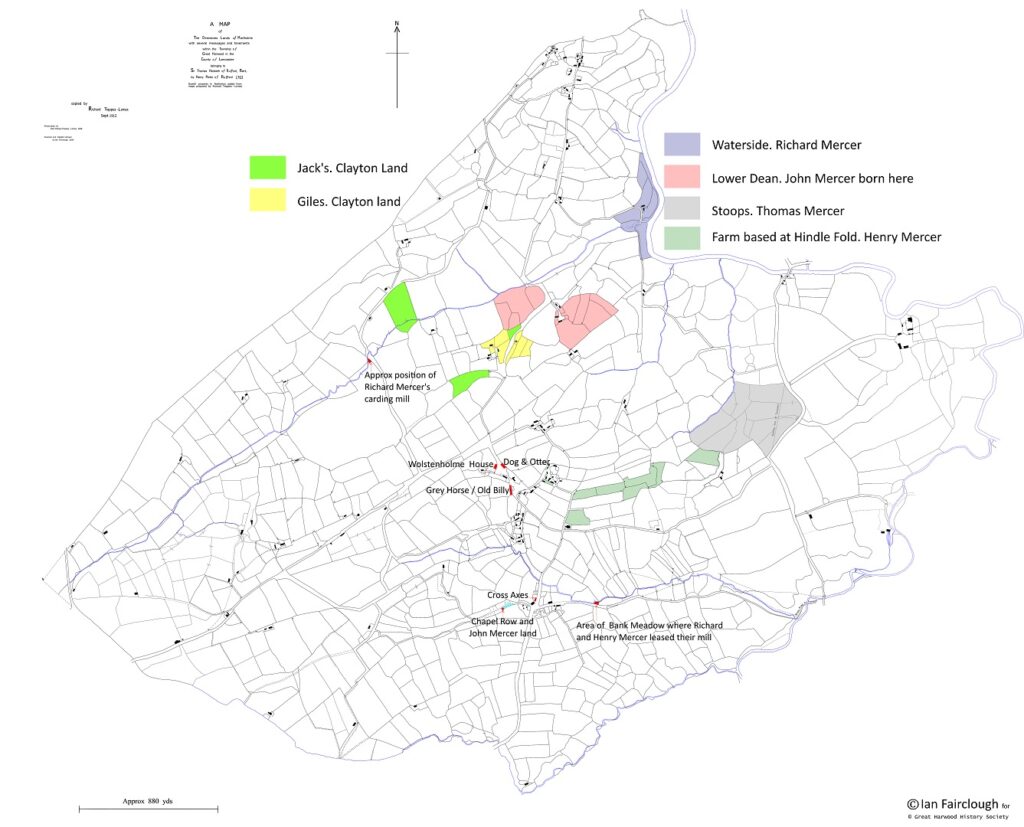
Henry Mercer, fourth child of Thomas, married Jennet Hindle in 1783. Their first child was recorded in the baptism registers as being born at Hindle Fold and it seems that Henry and Jennet lived there the whole of their married life.
Sales particulars for the Hesketh estate in 1803 list the lands that Henry was leasing:
- House, outhousing, and garden
- Church Field
- Long Fields
- New Hey
- Ox Hey
- New Hey Meadow
- Lower New Hey
Customary acres 8a 1r 6p; statutory acres 13a 1r 27p.
Terms were seven years from Candlemas and May 1803 at rent of £16 16s.
The farmhouse would be at Hindle Fold while the lands were what later became the graveyard behind the church and what are now the playing fields and beyond.
Henry died at Hindlefold in 1836 and Jennet in 1842. The 1841 census shows that she was living with her youngest son John and his family. The Trappes-Lomax rent ledger 1817 – 1849 shows Henry making payments starting at £42 per year, but reducing to £25 per year. The fields aren’t named but it is probable that fields were taken from this farm and added to others.[2]
Richard, the youngest child of Thomas Mercer of Stoops, went into business with Henry in the later years of the eighteenth century. Their nephew John Mercer talks of Henry setting up a ‘hand loom cotton factory’ in the Lower Town and documents in the Trappes-Lomax collection confirm this, but that Richard Mercer, brother of Henry, was a partner:
21 July 1792. R G Lomax to Henry and Richard Mercer of Great Harwood, cotton spinners – demise of Cotton mill for carding cotton in a meadow called Bank meadow in Lower Town of Harwood and water wheel and other machinery, dam, lodge and water. Term 21 years: rent £27 12s.
Rather than a small hand loom factory this was a carding factory. It isn’t known when this enterprise ceased, there are no further records relating to the factory. John Mercer also said that his uncle Richard had such a factory at Goldacre Lane, so perhaps the enterprise moved there at some stage.
Richard married Ann Clayton in 1790. Ann was the sister of Betty Clayton, second wife of Richard and Henry’s brother Robert and mother of John Mercer. The Claytons had leased tenements in the Bowley area since at least the early 1700s; two tenements that no longer stand and known as Jack’s and Giles’s which were on opposite sides of Dean Lane. Richard’s occupation when he married was given as cotton carder, which predates by two years the lease of Bank Meadow. Around the time that Richard married the parish register entries almost completely stop recording exactly where people were living so it isn’t possible to say from the registers where Richard and Ann lived after their marriage. However, the survey of the Hesketh lands in 1803 shows that Richard and Ann were tenants at Waterside, a farm long gone but that was just over the clapper bridge where Dean Brook enters the Calder.
- House and cottage with gardens etc
- Croft
- Higher Croft and Lane
- Holme
- Woods etc.
Customary acres 5a 3r 36p – statutory acres 9a 2r 28p
Three years from Candlemas and May 1803 for rent of £15.
The family seem to have rented Waterside for much longer than three years, the death of Ann, wife of Richard being recorded there in 1838. Richard died in 1842, not at Waterside but at Heymoor which his son Thomas was now renting, and who is listed as the tenant in an estate survey made in 1840.
In 1797 another Richard Mercer married Ann Haworth, and so it isn’t clear quite how many of the children listed as being the children of a Richard Mercer and Ann his wife belong to the Waterside family. Richard and Ann’s first child was Jonathan who was born before their marriage and for whom there is no record of baptism; he was always known as Jonathan Clayton. Their second child, Mary, was also born before they married but baptised on the day that they married. Mary was recorded as Mary Mercer when she died aged twenty. Thomas, son of Richard and Ann, wasn’t baptised until 1860 so it is clear that not all of their children were baptised. I have only included in the pedigree those children who are certainly the children of Richard Mercer and Ann Clayton.
The father of John Mercer the chemist, Robert Mercer, was the fifth child of Thomas Mercer of Stoops and born there in 1756. He seems not to have fared quite as well as his older and younger brothers and there could be a hint as to why in this quote from Benjamin Hargreaves in his Recollections of Broadoak, describing a walk taken by himself and John Mercer:
‘There,’ said Mr. Mercer, ‘Mr. Roger Cunliffe,[3] lived before he turned his attention to banking in Blackburn. ‘My father,’ said my companion, ‘was of a convivial turn, and liked society. Mr. Cunliffe, when he heard of him wasting his time, as the thought, in anything of the sort, used to come down and give him a blowing up.’
Robert Mercer first married Betty Birtwistle and they had three daughters, Mary, Betty and Ann. Ann is mentioned in the autobiography of her half-brother John Mercer, but it is not yet clear what became of Mary and Betty.[4] Betty, wife of Robert died in 1784. Robert then married Betty Clayton in 1786 and they had three children, Thomas, John (the chemist) and Richard.
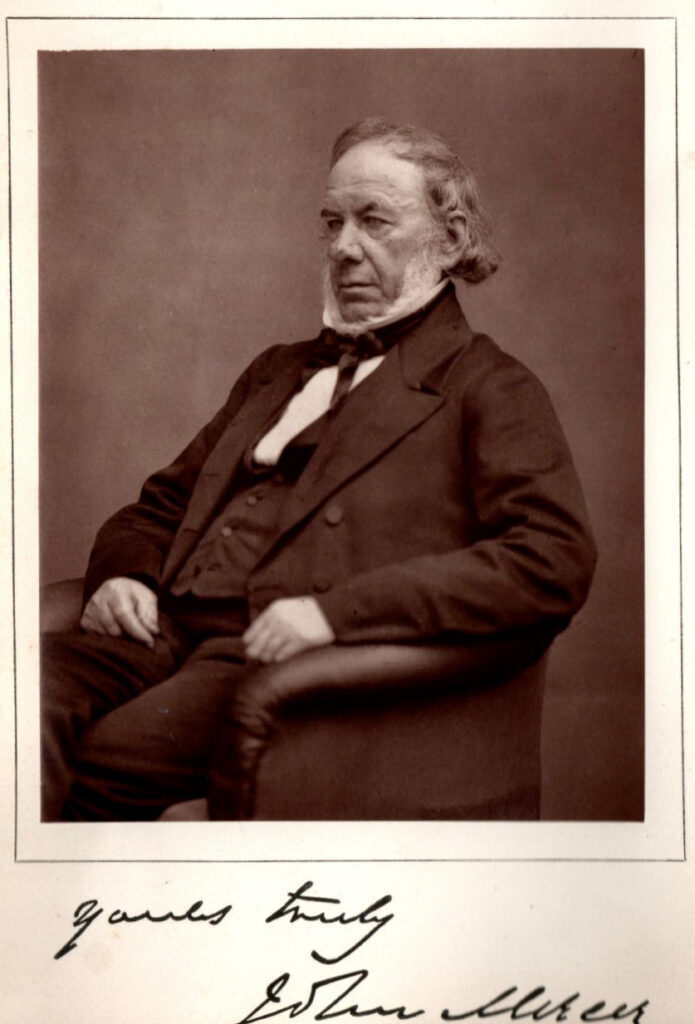
John Mercer the Chemist was born in February 1791 at Dean in Great Harwood. There has been a lot of speculation over the years as to exactly where this may have been, however he took Benjamin Hargreaves on a walk to his birthplace, and it is easy to follow their route as described later by Hargreaves in his Recollections of Broadoak. He stated to Benjamin that the house had been pulled down and the house shown on the map as Dean had indeed gone by the time of this walk.
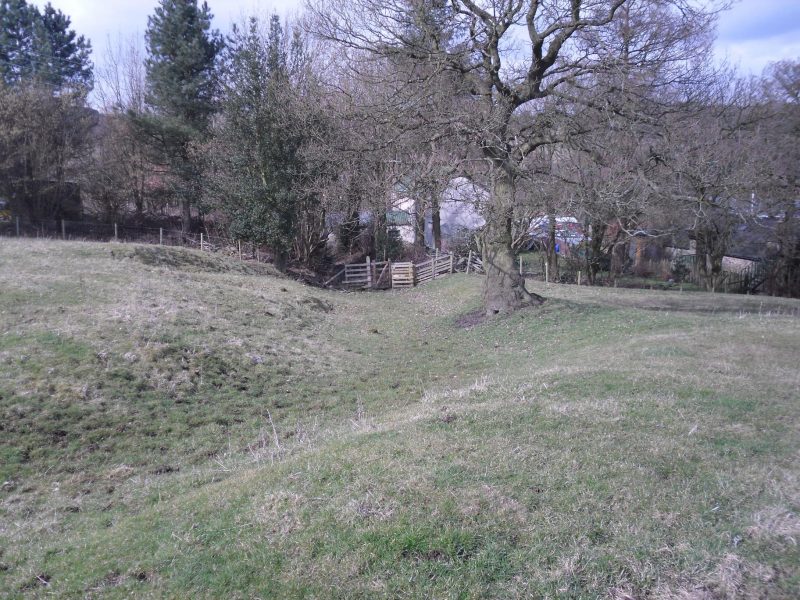
While John was still a small boy the family had to leave Dean and move to the Lower Town, ‘to a small farm’. There have been suggestions that the small farm was Butts Farm or Swain Fold, but land tax records show that Robert was paying a very small amount so the ‘small farm’ was likely to be little more than a cottage with a garden. Soon after the move his father became ill and died when John was just eleven years old in 1802, and his brother Richard died soon afterwards aged just ten. John, his mother and his brother Thomas now faced hard times; John recalled that his mother had so little money for food that she made him go and look for Patience Dock, a herb, so that she could make a meal from it.
At about this time John started work, winding cotton onto bobbins ready for weaving. At the house where he worked lived a man called Blenkinsop who owned some books, which John was always looking at, so Blenkinsop decided to teach John to read and write. Basic mathematics followed and his education was taken up by John Lightfoot, an exciseman. John became very interested in music and taught himself how to read music. He became part of a group of singers who became good enough to sing at many Churches in the area, including Whalley, Altham and Padiham.
John’s mother was asked to live with her own mother at the Back o’Bowley,[5] but John didn’t get on with his cousin Jonathan Clayton, and so for a time moved about between other relatives. By the age of sixteen John was a hand loom weaver. His mother had married again to another Mercer, Thomas Mercer of the Egg Syke family and John had a half-brother William. John’s lifelong interest in colour mixing and dyeing probably began when he saw a gown that his new baby brother was wearing, which was orange and which his mother had dyed herself. John bought, from a chemist in Blackburn, little twists of all the chemicals that were used in colour mixing and began to experiment.
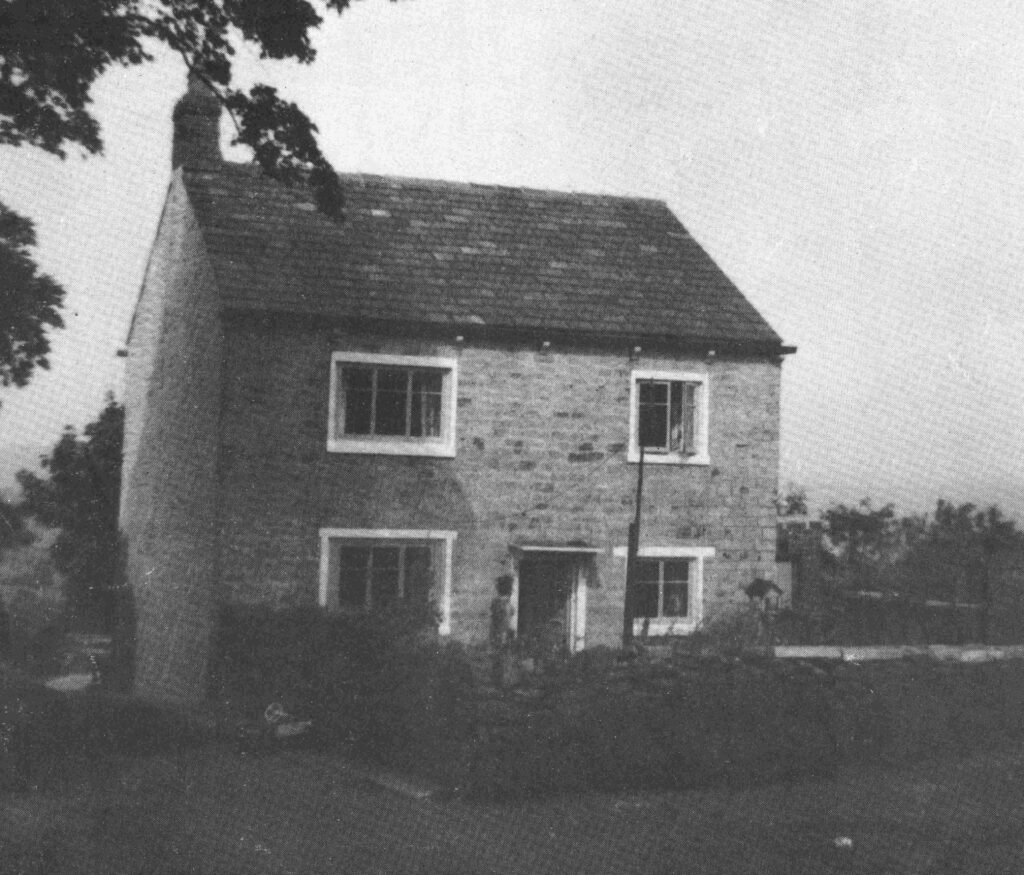
Although there were no large cotton weaving mills in Clayton or Harwood at this time, there was, in Clayton le Moors at Oakenshaw, a printworks, that took the cloth produced locally and dyed and printed the cloth. At this time a Mr. Hargreaves was in charge at Oakenshaw and he heard of John’s reputation for dyeing so asked him to be an apprentice. His mother agreed and John was bound an apprentice at the age of seventeen. John didn’t get on with one of the other employees though and gave this up after only 10 months, going back to live at Dean Lane with his mother and step-father, in the house still standing on the east of the lane.
Shortly after, both his mother and her husband died and John had to move once again, first to live with his uncles at Hindle Fold, and then to live with a family called Wolstenholme at the farm opposite the Dog and Otter. John began to court Mary Wolstenholme and they married in 1814. John was taken on at Oakenshaw Printworks again and in 1828 he became a partner in the firm and remained so until 1848. He moved to Clayton, first near the Printworks and sometime between the census years of 1841 and 1851 to Oakenshaw Cottage.
He had many interests, he experimented in photography and produced experimental colour prints. His interest in medicine led him to produce an ‘iron’ medicine’. In 1844 he discovered a way of treating cotton that gave it the appearance and feel of silk: this became known as Mercerisation. The process is still used today. In 1851 he exhibited the process at the Great Exhibition in London and presented Queen Victoria with a set of Mercerised handkerchiefs.
John Mercer was a religious man, a Methodist, and he contributed towards the building costs of both Butts Chapel and All Saints Parish Church in Clayton le Moors. He also became a Justice of the Peace and was active in local affairs.
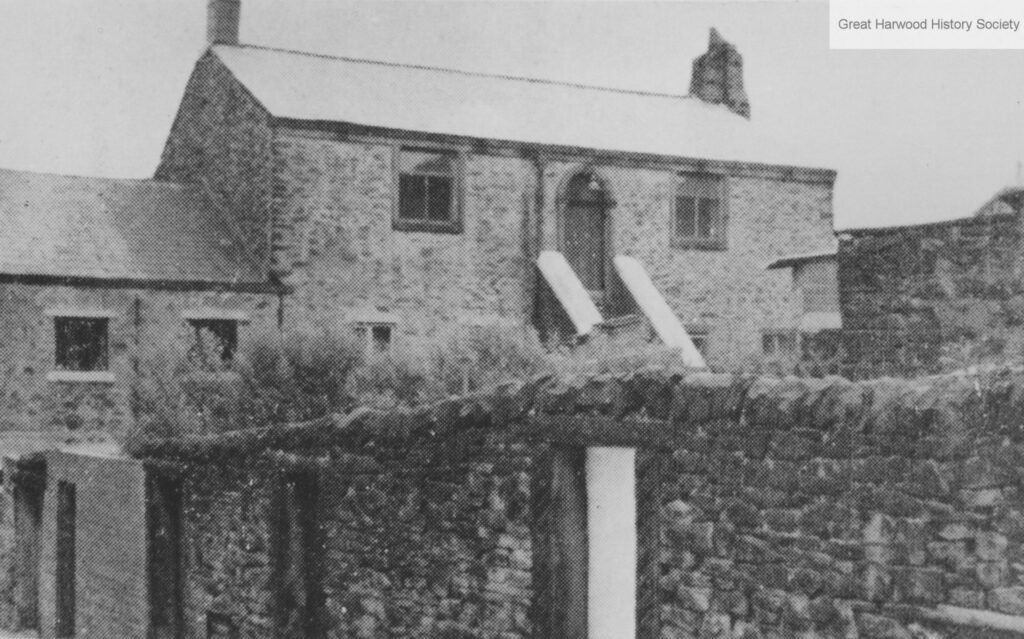
John’s wife Mary died in 1859. They had six children, but none of them married or had children. John Mercer died in 1866 aged 75. His daughter Maria died in 1913 aged 93 and she left the house and grounds of Oakenshaw Cottage to be made into a park and money for the erection of Mercer Hall in Great Harwood. The Mercer Memorial Clock Tower on the Town Gate commemorates the life and achievements of John Mercer and the opening ceremony was on 20 June 1903.
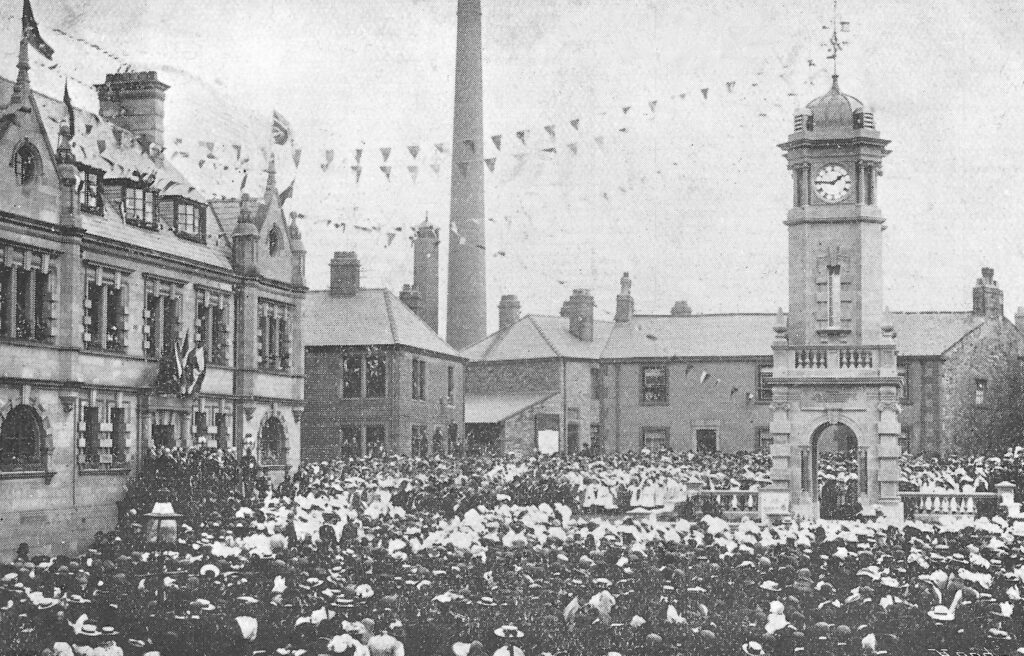
The Mercer Memorial Souvenir has a full account of the proceedings and details for the clock tower. See here for an essay about the item at the top of the tower.
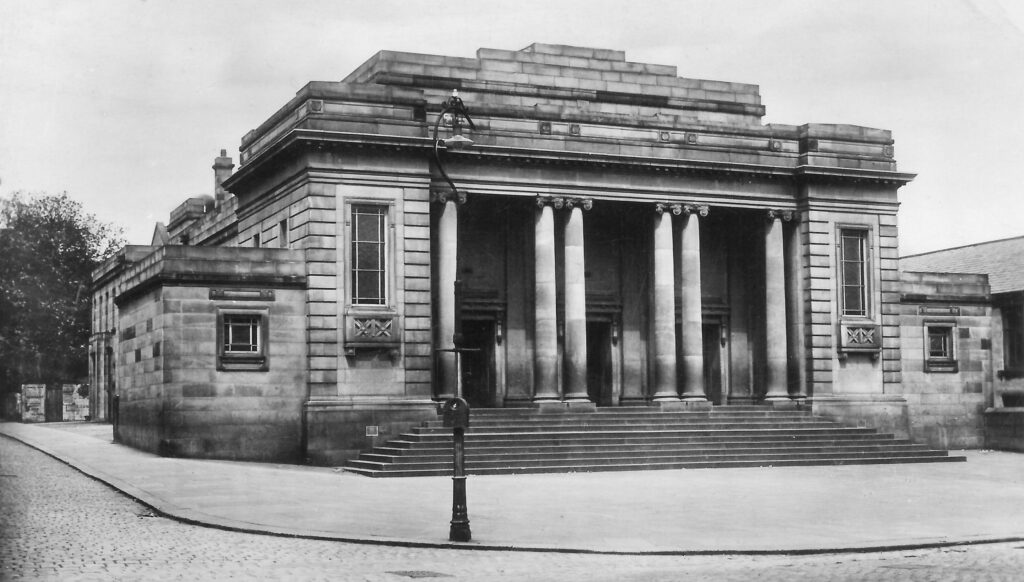
Although John Mercer has no direct descendants there are many people who can trace their ancestry to this branch of the Mercer families of Great Harwood through his brother, half-brother, uncles, and aunts.
[1] A plodweaver wove checked cloth or plaid.
[2] Church Field was not sold to the church for a graveyard until 1856.
[3] Of the banking concern of Cunliffe, Brooks and Co.
[4] The affidavit (see here) produced in relation to the will of Robert Clayton Mercer states that there was only one child of the marriage, Ann and although only Ann is mentioned in the autobiography of John Mercer examining the parish registers does suggest strongly that these two baptisms are children of Robert Mercer and Betty Birtwistle.
[5] This would be at either Giles or Jacks, both Clayton tenements although long since pulled down.
Pedigrees of the Mercer Families of Stoops
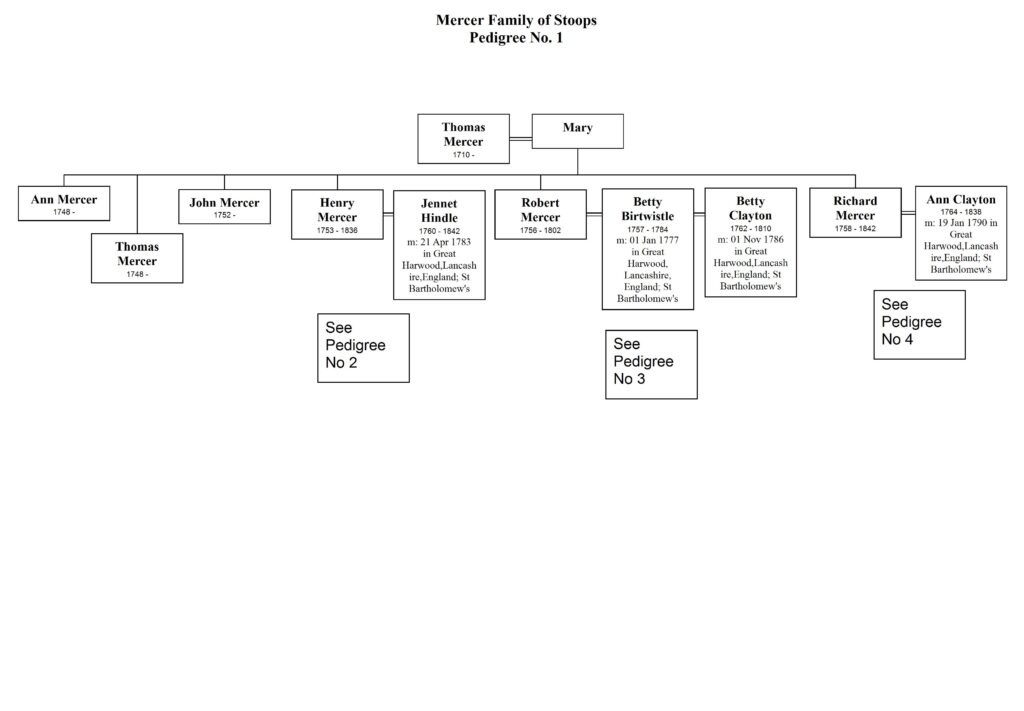
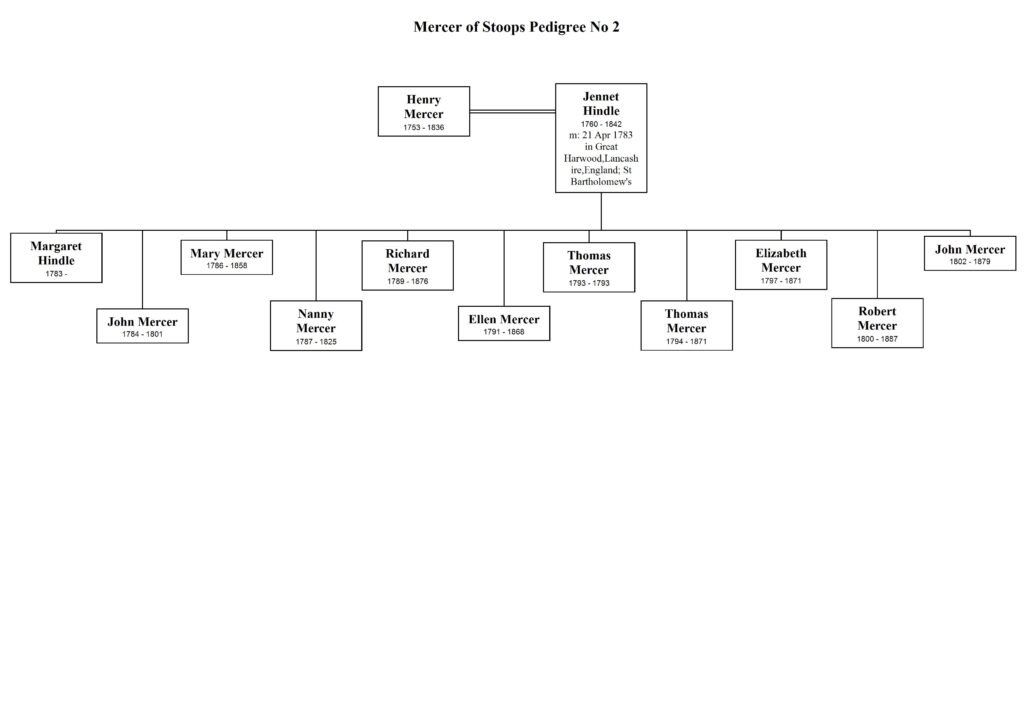
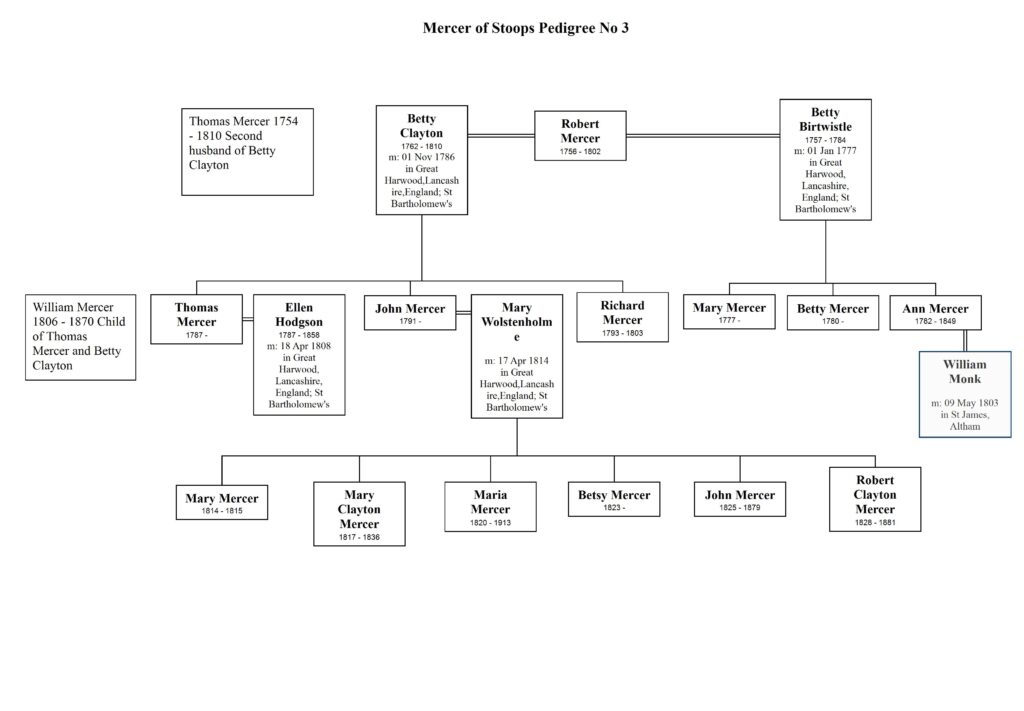
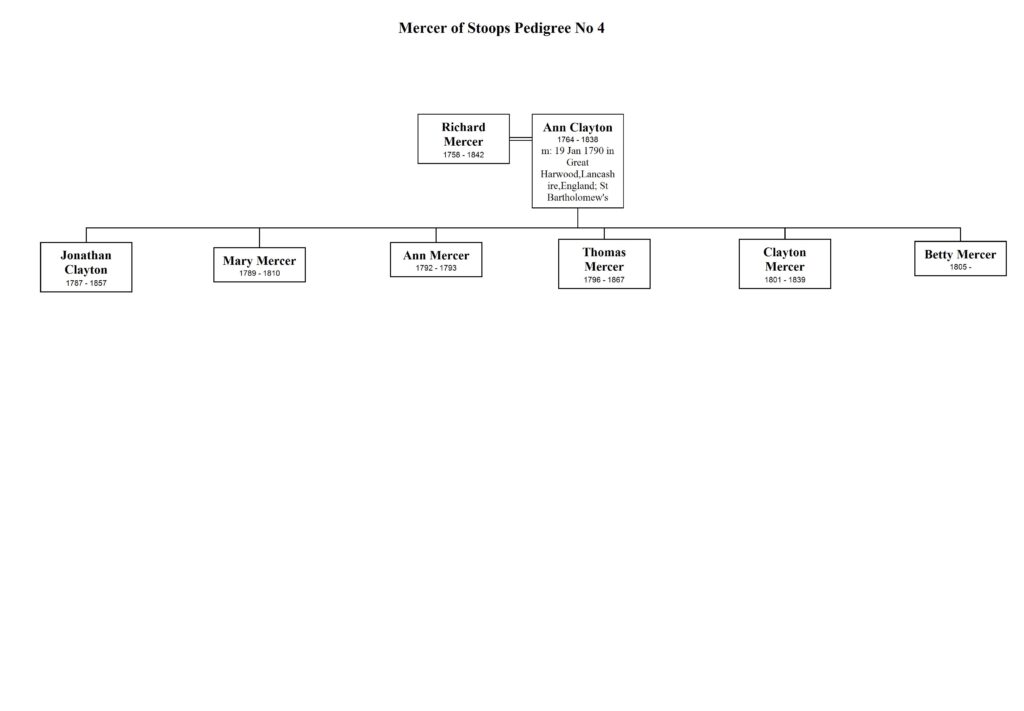
SOURCES AND CREDITS
Copyright B.Youds and Great Harwood History Society 2021
Thanks also to Ian Fairclough for the map of Mercer lands based on a map held by JM Trappes-Lomax.
Links are included to transcriptions of material on this site.
| Survey of the Estates of Thomas Mercer c. 1735 | Manchester Archive L1/35/5 | |
| Parish Registers of Great Harwood | Printed transcription and accessed from Ancestry.co.uk | |
| Trappes-Lomax lease register | Lancashire Archive DDLX 1/1 | |
| Field map of Great Harwood c 1763 | JM Trappes-Lomax | |
| Holographic autobiography of John Mercer | Lancashire Archives | |
| SECONDARY SOURCES | ||
| Eaton, H E | Genius of Great Harwood | |
| Hargreaves, B. | Recollections of Broadoak | |
| Trappes-Lomax, R | History of the Township and Manor of Clayton le Moors |